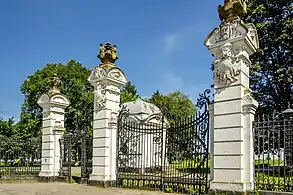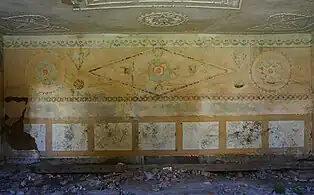49°48′30″N 26°52′00″E / 49.808333°N 26.866667°E



Antoniny Palace (Ukrainian: Антонінський палац) was a palace of the noble Sanguszko and Potocki families in Antoniny, Ukraine. It was destroyed during the Russian Civil War in August 1919. Today the park and various service buildings remain, such as the stables.
History
In the 1760s, Barbara Sanguszko (1718–1791), grants for long-term use the village and estate of Holodky to Ignatius Malchevsky, who was married to her sister Antonina, and was regent of the royal chancellery.[1] The couple settled in Holodky, and decided to construct a palace and a garden.[1] Ignatius named the palace after his beloved wife Antonina.[1] The name also became associated with the village, so Holodky became Antoniny.[1]
At the start of the 19th century, the castle returned to the Sanguszko family, who further renovated the palace and turned into a splendid estate.[2] When Maria Klementyna Sanguszko (1830–1903) married Alfred Józef Potocki (1822–1889), Antoniny palace transferred to the Potocki family.[3] When her husband died, she transferred the palace to her younger son, Józef Mikołaj Potocki (1862–1922).[4] The elder son, Roman Potocki, inherited Łańcut Castle.[4]
Józef Potocki was one of the richest magnates in the Russian empire, a lover of nature and an avid hunter.[2][5] He travelled the world around for it, not only Poland, but also India, Ceylon and Africa.[5] This was also reflected in Antoniny, which was rebuilt into a neo-baroque residence. The reconstruction happened in various phases: the Austrian architects Fellner & Helmer did the first work in the 1870s. The French architect François Arveuf was involved between 1897 and 1903 adding a guest wing and redesigning the interior.[2] And Ferdinand Fellner again between 1905 and 1908, adding a new entrance.[2]
The new renovated palace was full of elegance and luxury.[5] It became famous for its stud of Arabian horses,[6][7] and its cellars having the most exotic liquors. The reception halls were decorated with hunting trophies. Also, the palace room housed a large art collection, consisting of paintings, porcelain (e.g. Sèvres, Saxon and Korets) and books.[2] Józef gathered in his library around 20,000 volumes. The garden and park around the palace were around six thousand hectares in size.[2] Józef arranged here one of the largest menagerie parks of Europe, where he arranged many hunts but also bred animals that were not used to the European climate.[2][5]
During the first World War, the palace was guarded by clerks and administrators.[2] But it did not help, in the Russian Civil war which followed, the Bolsheviks set the palace on fire. It lasted several days in August 1919, and destroyed the entire mansion.[2] During the fire, employees and some residents of the estate moved part of the collections (artworks, furniture, library and archive) to nearby stables and campers.[2] In 1920, they were transported to Warsaw. The transferred collections were destroyed during the Warsaw Uprising in 1944.
In the 1960s, a sport stadium was constructed on the site of the palace.[2] What now today remains, are only the landscape park and some ancillary buildings, such as the stables.[2] The entrance gates still bear the coat of arms of the Sanguszko and Potocki families.[2]
Image gallery: The palace in its heyday
 The palace in the 19th century
The palace in the 19th century The palace before the neo-baroque rebuilding
The palace before the neo-baroque rebuilding.jpg.webp) The palace and its stables opposite
The palace and its stables opposite A view of the stables and the gates in 1912
A view of the stables and the gates in 1912 Camels at the palace
Camels at the palace Entrance to the palace in 1916
Entrance to the palace in 1916 A hunting party at the steps of the palace
A hunting party at the steps of the palace A hunt at the Antoniny estate
A hunt at the Antoniny estate
Image gallery: What has remained
 The palace gates with the coat of arms of the Sanguszko and Potocki families
The palace gates with the coat of arms of the Sanguszko and Potocki families Another view of the palace gates
Another view of the palace gates Another view of the palace gates
Another view of the palace gates A dilapidated guardhouse
A dilapidated guardhouse A former service building
A former service building A former service building
A former service building_%D0%90%D0%BD%D1%82%D0%BE%D0%BD%D1%96%D0%BD%D0%B8.jpg.webp) A former service building
A former service building Remains of the interior in a service building
Remains of the interior in a service building
References
- 1 2 3 4 "Антоніни (Antoniny)". castles.com.ua/ (in Ukrainian). Retrieved 1 November 2023.
- 1 2 3 4 5 6 7 8 9 10 11 12 13 "Клаптик Англії на Волині: Антоніни графа Потоцького (A Patch of England in Volhynia: Antonines of Count Potocki)". bbc.com/ (in Ukrainian). Retrieved 1 November 2023.
- ↑ "Антоніни. Фахверкове містечко (Antoniny Half timbered town)". ukrainaincognita.com (in Ukrainian). Retrieved 1 November 2023.
- 1 2 Pratt, Michael; Trumler, Gerhard (1991). The Great Country Houses of Central Europe: Czechoslovakia, Hungary and Poland. New York: Abbeville Press. p. 380. ISBN 978-0896599420.
- 1 2 3 4 "Ostatni portret Józefa Potockiego (Last Portrait of Józef Potocki)". www. zamek-lancut.pl (in Polish). Retrieved 1 November 2023.
- ↑ Derry, Bred for Perfection, pp. 107–108
- ↑ Archer, Arabian Horse, pp. 56–57
External links
- "Антоніни (Antoniny)". castles.com.ua/ (in Ukrainian). Retrieved 1 November 2023.
- "Антонінський палац на Волині: розкіш та екзотика (Antoniny Palace in Volyn: luxury and exoticism)(Ukrainian podcast on Antoniny palace)". vsn.ua (in Ukrainian). Retrieved 1 November 2023.